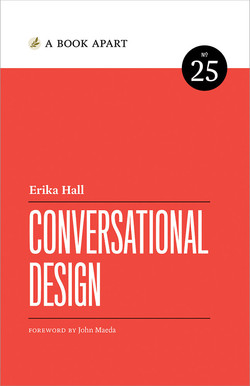Conversational Design by Erika Hall
Conversational Design could have been a straightforward view on the emergence of voice interfaces such as Alexa or the UI of customer service bots that live in the bottom right-hand corner of many sites. Instead, Erika Hall explores the rich possibilities of conversational language in UX from a more holistic and inquisitive standpoint. It's a much better book because of that.

ISBN: 978-1-952616-30-3
Published: March 6, 2018
https://abookapart.com/products/conversational-design
Reading notes:
The Human Interface
The first section of the book really sings with its take on the history of spoken language at the centre of human interaction. Burned in my mind are two important insights it brings to the forefront.
In oral culture – “All knowledge is social and lives in memory”
A written culture – “Promotes authority and ownership”
“These conditions may seem strange to us now (oral culture). Yet, viewed from a small distance, they’re our default state. Because our present dominate culture and the technology that defines it depends upon advanced literacy, we’ve become ignorant of the depths of our legacy and blind to the signs of its persistence.”
The contrast in power dynamics is pronounced, transitioning from the shared ownership of knowledge in oral traditions to the individual possession we see today. Our current written and digital culture is held to together with concepts of individualism, intellectual property, single sources of authority and ownership at its heart.
The book outlines the key material properties of oral culture as:
Spoken words are events that exist in time.
It’s impossible to step back and examine a spoken word or phrase. While the speaker can try to repeat, there’s no way to capture or replay an utterance.All knowledge is social and lives in memory.
Formulas and patterns are essential to transmitting and retaining knowledge. When the knowledge stops being interesting to the audience, it stops existing.Individuals need to be present to exchange knowledge or communicate.
All communication is participatory and immediate. The speaker can adjust the message to the context. Conversation, contention, and struggle help to retain this new knowledge.The community owns knowledge, not the individuals.
Everyone draws on the same themes, so not only is originality not helpful, it is nonsensical to claim an idea as your ownThere are no dictionaries or authoritative sources.
The right use of a word is determined by how it’s being used right now
I am now reading Walter Ong “In Orality and Literacy: The Technologizing of the Word” which is reference in this part of the book.
Principles of Conversational Design
The 'Principles of Conversational Design' chapter begins by defining an interface as 'a boundary across which two systems exchange information.' It quickly moves to argue that conversation is the original interface and remains the most widely understood and utilized.
Hall then explores the language philosopher Paul Grice's work on the four conversational maxims, and Robin Lakoff's work on 'The Logic of Politeness,' which introduces a fifth maxim.
The conversational maxims are the cooperative foundation or rules by which humans communicate effectively through conversation, referred to by Grice as the 'Cooperative Principle.
The conversational maxims
Maxim of Quantity: Information
Make your contribution as informative as is required for the current purposes of the exchange.
Do not make your contribution more informative than is required.
Maxim of Quality: Truth (supermaxim: "Try to make your contribution one that is true")
Do not say what you believe to be false.
Do not say that for which you lack adequate evidence.
Maxim of Relation: Relevance
Be relevant.
Maxim of Manner: Clarity (supermaxim: "Be perspicuous")
Avoid obscurity of expression.
Avoid ambiguity.
Be brief (avoid prolixity).
Be orderly.
Maxim of Politeness (Robin Lakoff)
Don’t impose
Give options
Make the listener feel good
The Rest of the Book
The remainder of the book explores the practice of implementing Conversational Design within UX. It is well-written and contains a wealth of valuable material. At this point in time, my interest lies in researching the new linguistic user interfaces being built around LLMs (large language models) and AI chat. The first half of the book delivered that for me.
There are a number of points to extract from the rest of the book:
When confronting a new system, the potential user will have these unspoken questions.
Who are you?
What can you do for me?
Why should I care?
How should I feel about you?
What do you want me to do?”
The last questions “What do you want me to do?”. is reflected on later in the book by quoting Jim Kalbach’s work with navigation
Expectation setting: “Will I find what I need here?”
Orientation: “Where am I in this site?”
Topic switching: “I want to start over”
Reminding: “My session got interrupted. What was I doing?”
Boundaries: “What is the scope of this site”
Follow up links and reading:
https://abookapart.com/products/conversational-design
https://en.wikipedia.org/wiki/Walter_J._Ong
https://en.wikipedia.org/wiki/Paul_Grice
https://en.wikipedia.org/wiki/Robin_Lakoff
https://en.wikipedia.org/wiki/Cooperative_principle
https://experiencinginformation.com/